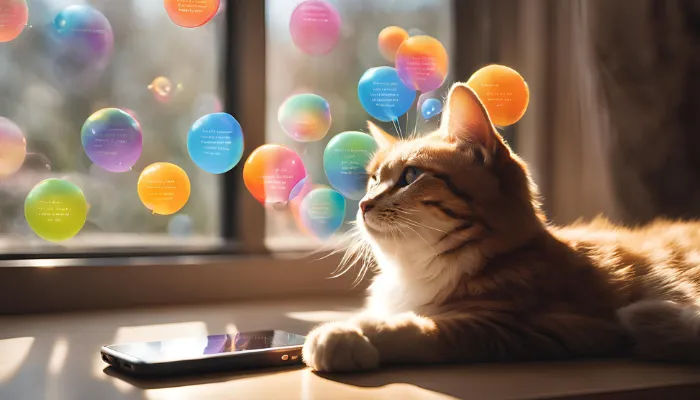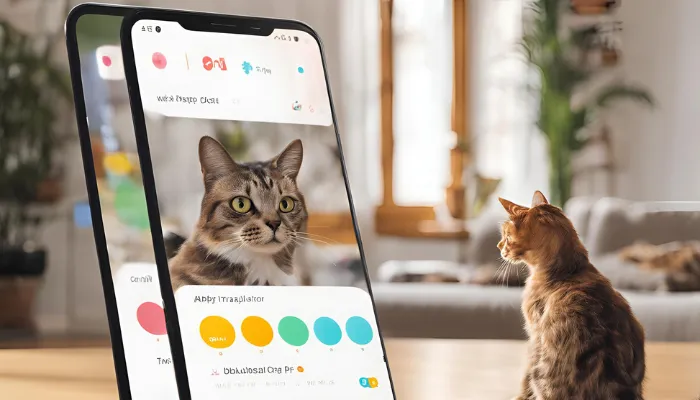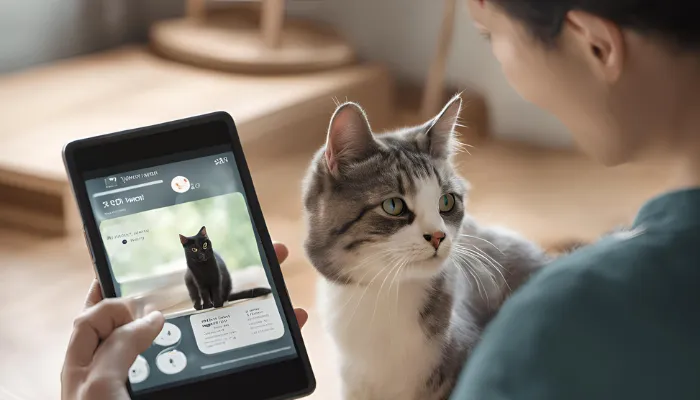If you’ve ever wanted to understand how to speak cat translator, a cat translator can fill in the communication gap between you and your pet cat, you aren’t the only one. Felines have their own way of communicating, and learning their language can make the relationship much stronger. Regardless if you are an experienced cat owner or a newer cat mother or father, understanding “cat speech” is both interesting and very rewarding.
In this article, we will draft a step-by-step guide on how to make a cat-to-human translator focusing on the science behind cats talking, tech behind it, and steps you yourself can take.

How to Speak Cat Translator: Understanding the Basics
Before jumping into building a cat to human translator, it’s essential to grasp how cats communicate naturally. But can a how to speak cat translator really decode these signals? Unlike dogs, cats rely heavily on subtle cues like body language, vocalizations, and even scent marking.
Key Elements of Cat Communication:
- Vocalizations: Cats use meows, purrs, hisses, and growls to express different emotions.
- Body Language: Tail positions, ear movements, and posture convey a lot about their mood.
- Facial Expressions: Dilated pupils, whisker positions, and even blinking can tell you what your cat is feeling.
- Scent Marking: Though not something a how to speak cat translator can decode easily, cats often use scent to communicate with other cats.
Common Cat Sounds and Their Meanings:
| Sound | Meaning |
|---|---|
| Meow | General attention-seeking or request |
| Purr | Contentment or sometimes discomfort |
| Hiss | Fear, aggression, or annoyance |
| Chirp/Chatter | Excitement, often when watching birds |
| Yowl | Distress or mating behavior |
By understanding these basic elements of cat communication, you’ll be better prepared to interpret their signals and make the most of any how to speak cat translator tool.

Advanced Techniques for a More Accurate Translator
To make your how to speak cat translator even more accurate, you can incorporate more advanced methods.
Using AI and Machine Learning:
Machine learning algorithms can help refine your translator by identifying subtle differences in vocalizations. Here’s how you can use AI:
- Collect more data: The more recordings you have, the better.
- Label your data: Identify what each sound means.
- Train a model: Use platforms like Google’s TensorFlow or Microsoft’s Azure to build a model.
- Test and refine: Continuously test your translator to improve its accuracy.
Integrating with Smart Devices:
Imagine connecting your how to speak cat translator to your smart home devices! You could program it to:
- Send you a notification when your cat is hungry.
- Turn on a toy when your cat wants to play.
- Alert you if your cat is distressed.
By leveraging AI and smart technology, you can create a highly responsive cat language translator that deepens your connection with your feline companion.

Challenges in Building a Cat to Human Translator
Developing an accurate cat-to-human translator is certainly not an easy task, as it presents a variety of technological and biological challenges. However, if you’re curious about how to speak cat translator technology works, understanding these hurdles can give you better insight.
- Individual Cat Sounds:
- Every single cat has a unique set of sounds and vocal patterns which makes every cat feel like an entire new language. This makes it nearly impossible for a universal cat translator to interpret the meows, purrs, and hisses of every cat.
- Lack of Research:
- Cat sounds and their interpretations have not been thoroughly studies, unlike human languages. Speaking of databases, there is not sufficient standardized sounds, which makes developing algorithms near to impossible.
- Changes in Tone:
- Due to the cat’s variation of meows, technology might face difficulty understanding them because the pitch it is in might resemble a different emotion. For instance, while famished, a cat’s meow will depict its discomfort while feeling very on edge.
- More Than Sound:
- Cats communicate through more than sounds; they also use body language and environmental signals. These important signals are often lost in a how to speak cat translator focused solely on vocalization.
- Reach of Machine Learning:
- Machine learning tries its best to improve translations at every given point, but fails time and again with cat sounds. Which makes it unreliable when used with different cats in distinct situations.
Even with all these setbacks, the development of technology and research progress continues to enhance cat-to-human translators while providing a great and engaging method to interact with your cat.
Tips for Better Communication with Your Cat
Building a stronger bond with your cat starts with understanding how they communicate and responding in ways they recognize.
1. Pay Attention to Body Language:
Cats express a lot through their posture, tail movements, and ear positions. A relaxed body and upright tail usually mean your cat is happy, while flattened ears or a flicking tail may signal irritation.
2. Learn Their Vocal Cues:
Each cat has unique sounds for different needs. Pay attention to the pitch, tone, and frequency of their meows to understand when they’re hungry, playful, or seeking attention.
3. Respond Consistently:
When your cat communicates, respond in a consistent way. For example, if they meow for food, feed them at regular times to reinforce their understanding.
4. Use Positive Reinforcement:
Reward your cat with treats, petting, or praise when they communicate in ways you appreciate. This encourages them to repeat those behaviors.
5. Respect Their Space:
Cats are independent animals and may not always want attention. Watch for signs they need space, like turning away, twitching tails, or hiding.
6. Engage in Interactive Play:
Using toys to play with your cat helps build trust and strengthens your bond. It also allows them to express natural hunting instincts in a safe way.
By tuning into your cat’s unique cues and responding thoughtfully, you’ll create a deeper, more meaningful connection with your feline friend.
Future of Cat to Human Translators
As new technologies emerge, the prospects for how to speak cat translator tools look very encouraging, providing novel ways to strengthen the bond we share with our cats.
- Improvements in AI and Machine Learning:
- The more advanced cat to human translator apps will probably incorporate sophisticated AI algorithms that have the potential to analyze more variations of cat sounds. This will help translations become more accurate not only by learning general cat sounds but also the distinctive vocal sounds made by specific cats.
- Integration with Wearable Tech:
- Envision smart collars that monitor your cat’s vocalizations and body language in real-time, immediately alerting you about their mood and certain needs via your smartphone. Such integration would make cat communication far easier than before.
- Enhanced Data Gathering Techniques:
- As more cat owners utilize the cat translator app and other translation applications, they will be able to amass a larger database of feline sounds. This would make it easier to analyze and categorize cat sounds, increasing the reliability of the translations.
- Multisensory Translators:
- Such devices may be in future that can analyze sounds in conjunction with movement and even face detection to provide you with a comprehensive view of what your cat is trying to say.
- Improved Customization:
- The development of adaptive profiles that tailor to each individual cat’s actions and noises will assist pet owners in interpreting their feline companions’ distinctive forms of communication.
In the years ahead, with the refinement of these tools, how to speak cat translator devices could become more than just entertaining gadgets, perhaps changing the way we engage with and look after our cats.
FAQs About How to Speak Cat Translator
Curious about cat translation technology? Here are some frequently asked questions to help you understand how a how to speak cat translator works and what to expect.
1. Can a cat translator really help me understand my cat?
Identifying your cat’s vocal patterns can be relatively easy using a cat translator; however, these tools should be utilized in conjunction with body language to get an accurate understanding.
2. Do all cats meow in the same way?
No, every cat has their own distinct style of communication, which makes it hard for universal translation to come into existence. AI-based instruments aim to grasp certain cat sounds over a period of time and use them.
3. What technology is used in cat translators?
Cat translators often leverage a combination of AI, machine learning, and sound analysis tools for identifying the patterns of various meows, purrs and other sounds made by cats.
4. Will future cat translators be more accurate?
Thanks to the developing AI proficiency and improved methods of collecting data, future cat translators are likely to be more accurate by adding vocal, body language considering, and environmental context.
Evolution in technology has led to sophisticated cat-to-human translators that pet owners can bond with their feline friends more effortlessly.
Conclusion
In conclusion, if you’ve ever wondered how to speak cat translator, the journey is as fascinating as the destination. While creating a perfect translator might be challenging, understanding your cat’s vocalizations and body language can significantly improve your bond. By using technology, observation, and a bit of patience, you can bridge the gap between human and feline communication.
So, the next time your cat meows, you might just know exactly what they’re trying to say. And who knows? With advancements in technology, we might soon have a universal how to speak cat translator that brings us even closer to our furry friends.
